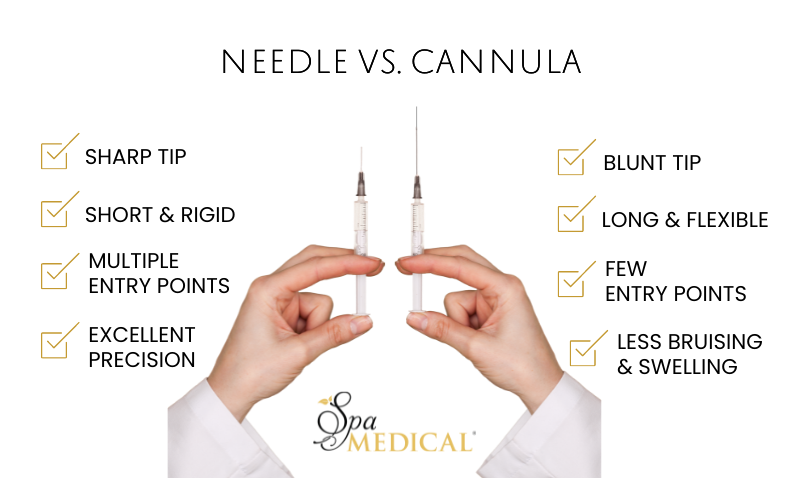Tuesday, June 21st, 2022
by Terri Harper, FNP-C
With multiple choices of dermal fillers, injectors, and techniques, it can be very confusing and frustrating when trying to decide which filler, which injector, and what to expect. Dermal filler treatments continue to rise in popularity among all ages both women and men. The indication for fillers is varied; ranging from restoring aging volume loss that contributes to sagging skin, depressions, and changing facial shape to simply enhancing younger features such as lips, cheeks, and jawline.
In my 20+ years as an aesthetic medical provider, I have seen the evolution of products, procedures and injection techniques for non-surgical anti-aging treatments. One of the recent options injectors have is using a cannula or blunt tip needle to inject dermal fillers in place of the traditional short, sharp needle. Both are adequate tools used for proper injections, but each has its pros and cons. There are two primary considerations when choosing a cannula versus a sharp needle: discomfort and risks.
What is a cannula?
First, let’s start by defining what a cannula is. A cannula is a flexible, blunt tip needle-like tool that attaches to the syringe of filler for delivery into the desired space. They come in various lengths and sizes to accommodate different filler properties. The blunt tip cannot pierce the skin for insertion so a sharp needle is used for the initial prick of the skin. The needle is removed and the blunt tip cannula is advanced into the skin through the piercing created by the needle.
Discomfort
You would presume a blunt tip needle to be less painful than a sharp needle. It is true in the sense of the sharp pricks felt during the insertion of the needle into the skin. A cannula, however, is felt more when advancing the needle under the skin and is uncomfortable and strange to some patients. I describe the differences between a cannula and the needle being advanced under the skin as such: the needle moves like a sharp knife through softened butter while the cannula feels like the tug of war of a dull knife pushing through a steak. For some patients, the initial prick of the needle is preferred while the cannula feels “too weird.”
Risks
Likely the most common side effect of dermal filler injections is bruising. Any puncture of the skin with a needle can create bruising. Usually, the fewer punctures of the skin required, the less bruising is seen. The smallest prick of the tiniest blood vessel can result in a slow leak of blood from the vessel and eventually create a visible bruise. As a sharp needle advances through the tissue being injected piercing a small blood vessel is likely to happen, especially in certain vascular-rich areas like the marionette depressions or the lips. The blunt tip cannula has the ability to glide over and under those tiny vessels to prevent a puncture leading to a bruise.
Arguably, the most dreaded fear and emergent complication of dermal filler injection is vascular compression or compromise. If the filler presses or occludes a blood vessel, particularly an artery, the blood supply of the area may be compromised to the point of damaging the tissue. Lack of blood supply to nourish the tissue can result in the death of the tissue and skin breakdown. The emergent nature of the complication varies depending on the location. For example, there have been reported cases of blindness if the ocular vessels are affected. The nose and frown areas are also at greater risk of necrosis if a vascular compromise occurs. The risk of intravascular occlusion is thought to be decreased with the use of a cannula since it is not sharp enough to penetrate most vessels. However, the use of a cannula does not guarantee no bruising will occur.
One side effect of injecting dermal filler is swelling or edema. It is documented that a cannula may induce less trauma to the tissue than a needle causing less soft tissue swelling and redness following injections. This is particularly true if a large area is being injected which would require multiple needle sticks using a sharp needle. Due to its length, the cannula offers the ability to cover a large area to inject filler through the initial needle prick. However, fillers have different hydrophilic properties causing some to swell more than others so the use of a cannula does not exclude edema following injection.








